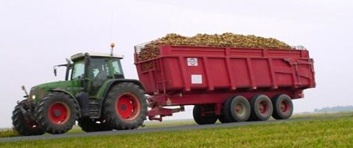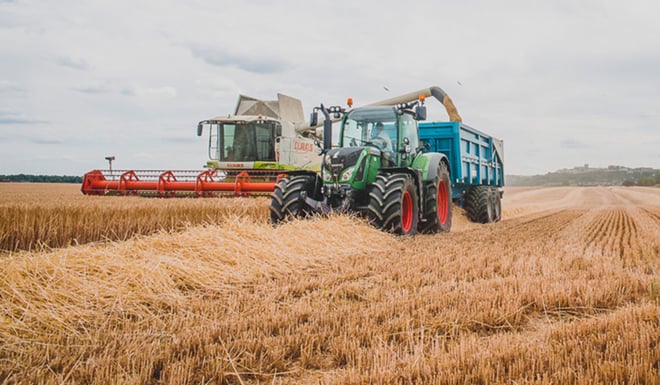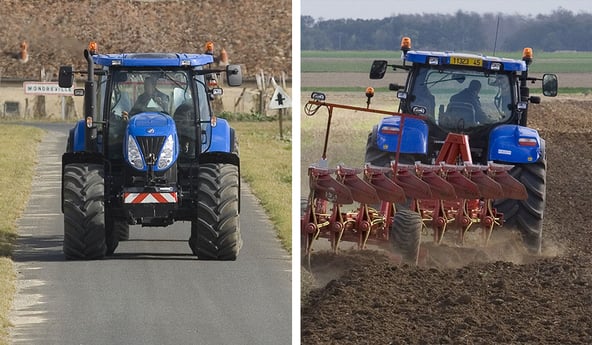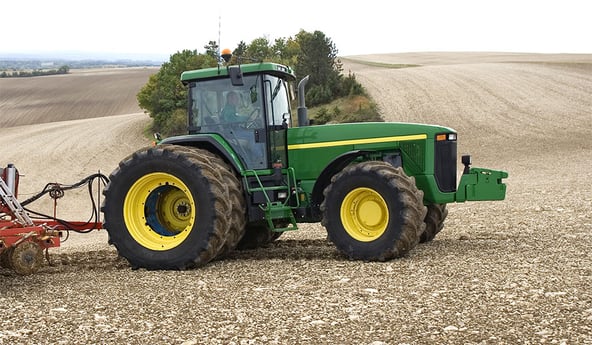After the main harvest, there is still a lot of work to do for many. Silage work, beetroot or potato harvests follow and represent periods of intense activity for you and your equipment.
During these harvests, your trailers have to transport heavy loads and the harvesting machinery used is very heavy, which means that your tyres are under enormous pressure, thus accelerating wear and tear.
So how do you avoid the deterioration of your tyres and preserve them during these intense periods?
Heavy loads accelerate the wear of agricultural tyres
Heavy loads increase the demands placed on the casing and tread of your tyres and can lead to permanent deformation. This deformation will result in an acceleration of the wear and a modification of the tyre footprint.
The distribution of weight is not optimal in this case and the risk of soil compaction is increased.
Check that your tractor tyres are the right size
PTo avoid premature deformation and ensure the resistance of your tyres, it is important to start by making the right choice of tyre. Check that your agricultural equipment’s load index is adapted to the maximum loads that you transport (to do so, refer to the load index table supplied by the manufacturers) and make sure that you do not overload your tyres by limiting the quantities transported if necessary. If the load index is insufficient, the casing may not be resistant enough.
Distribute the load evenly
For trailers with several axels, an even distribution of weight in the truck will enable a better distribution of the load over the different axels. The wear to the tyres will then be more even, which will allow you to keep your tyres for longer.
Increase the inflation pressure in the tyres
As always, the right inflation pressure is an essential point. A slight overinflation of the tyres will allow for heavier loads and will decrease rolling resistance. This will reduce wear as well as fuel consumption and improve grip and the stability of your agricultural vehicle.
High tyre pressure is not always the right choice, however, in particular if you are driving the same day on the road and in the fields, which is what happens during harvesting work. In this case, tyre inflation systems can be useful. They allow you to adapt pressure to the type of ground, load and speed. However, inflation time may be long and varies depending on the type of compressor used (from one minute with an additional compressor to about ten minutes if only the braking compressor is used), for an increase in pressure of 1 bar. In addition, these systems are still costly.
In order not to have to adapt tyre pressure when you go from fields to road or road to fields you can use high volume tyres. These are increasingly frequent on tractors and harvesting machines and are often VF tyres. The VF tyre can bear greater loads than standard tyres with the same inflation pressure. Its impact on the structure of your soil is therefore reduced. Another advantage of this technology is that the pressure does not need to be adapted depending on use (road of field).
Limit your speed when you have a very heavy load
To ensure your tyres last a long time, do not drive faster than the speed indicated by your equipment’s speed index. This would lead to excessive and dangerous heating.
 Furthermore, the behaviour of the rubber which composes the agricultural tyre depends on the pressure it endures (directly linked to the load) and the speed. It’s the combination of these two factors that affects wear.
Furthermore, the behaviour of the rubber which composes the agricultural tyre depends on the pressure it endures (directly linked to the load) and the speed. It’s the combination of these two factors that affects wear.
So, if you have a heavy load, a reduction in speed during trips by road will limit the demands on your tread. You will also limit the rubber heating and deforming.
Swap over your tractor tyres
If you notice that your tyres are wearing quicker on one side than the other and this is not due to misalignment or an error when mounting the tyre, you can swap over right and left tyres. The tyres on the right side do in fact often wear more rapidly because they are driven more often on the side of the road or because the often cambered form of the roads leads to a load transfer to this side.
Swapping over your tyres will therefore allow you to optimise overall wear.
Clean your tyres once the harvest is finished
And when the job is done, remember to clean the tyres property at the same time as you clean your equipment in order to extend their lifespan. Clean off any remaining earth particles and store your tools in a suitable place (for more details on adequate storage conditions, read the article: The 3 best techniques for storing your agricultural tyres).
Bridgestone-agriculture Blog is written and administered by tractor tyre experts who are available to provide you with advice on agricultural tyres. They will help you to maximise your productivity with information on all things relating to tyres: inexpensive tractor tyres, technical data for agricultural tyres, solutions for avoiding soil compaction, sprayer tyre pressure, why and how to ballast your tractor tyres, when to use dual-wheels, the mechanical causes for abnormal wear, discounted agricultural tyres, etc...
To learn more about ways to increase your farm’s productivity, bridgestone-agriculture has created a comprehensive eBook on the topic which is available for you to download for free:
Most people who read this article have also read some of the following articles:
This information is intended only to make you aware of the technical and functional aspects of agricultural tires and their use. It does not allow you to make a judgment or a definitive conclusion on a given problem. Only your agricultural tire expert is able to make a technical assessment and take a final decision, case by case.
Leave a
commentary
Your email address will not be published.
Required fields are indicated with *








